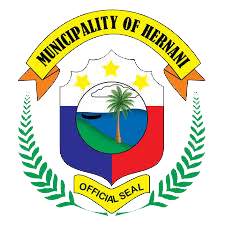History
A settler, named Miguel “Totoy Yadawon” Candido, from Guiuan, Samar, founded Hernani around the year 1850. Formerly called Nag-as (derived from the name of the river located southeast of the town proper), the settlement is in a flat coastal terrain facing the vast Pacific Ocean.
The diligence and determination of the early settlers propelled the rapid growth of NAG-AS. For a short period of time, tracks of cultivated lands planted to varied agriculture crops thrive in the verdant plains of the infant settlement. Its stable economic base is complemented by the abundance of domesticated animals and aquamarine resources. Reliable accounts also disclosed that early Chinese traders paid periodic visits to nag-as to trade their merchandize or barter with native products such as copra, cereals, root crops, dried fish, wooden carvings, herbs, fruits and more.
Nag-as reached the epochal point of its development when it was made a regular and independent municipality as embodied in a Royal Decree issued by Spanish Governor-General Rafael Echague on January 4, 1864. The royal fiat also mandated to change the old name Nag-as to Hernani.
Hernani was at the height of its progress and prosperity when a tragic event occurred. On October 12th, 1897, giant tidal waves struck the poblacion. The tragedy claimed more than 300 lives and the terrible waves destroyed the public buildings and houses including the newly-built stone church. The destruction and misery wrought by the tragedy compelled the survivors to resettle in a more secured place about one-half kilometer north of the abandoned town. The site is now the present poblacion.
Right after the Philippine-American War, the political status of Hernani was reduced into a barrio under the jurisdiction of Lanang (now Llorente). In 1912, its status as municipality was restored but the seat of local government was transferred to Pambujan (now Gen. MacArthur). However, in 1926 the municipality of Hernani regained back the township by virtue of an Executive Order issued by then American Governor-General Leonardo Wood.
Hernani is classified as a fifth class Municipality.
*
Msgr. Conrado C. Balagapo, Church Histo
Historical population
The population of Hernani grew from 6,622 in 1960 to 8,573 in 2015, an increase of 1,951 people. The latest census figures in 2015 denote a positive growth rate of 1.16%, or an increase of 503 people, from the previous population of 8,070 in 2010.
| Census date | Population | Growth rate |
|---|---|---|
| 1960 Feb 15 | 6,622 | – |
| 1970 May 6 | 6,216 | -0.62% |
| 1975 May 1 | 7,315 | 3.32% |
| 1980 May 1 | 7,032 | -0.79% |
| 1990 May 1 | 6,840 | -0.28% |
| 1995 Sep 1 | 8,055 | 3.11% |
| 2000 May 1 | 7,642 | -1.12% |
| 2007 Aug 1 | 7,974 | 0.59% |
| 2010 May 1 | 8,070 | 0.44% |
| 2015 Aug 1 | 8,573 | 1.16% |
|
Hernani
|
|
|---|---|
| Municipality of Hernani | |
|
Map of Eastern Samar with Hernani highlighted
|
|
|
Location within the Philippines
|
|
| Coordinates: 11°20′N 125°35′ECoordinates: 11°20′N 125°35′E | |
| Country | |
| Region | Eastern Visayas (Region VIII) |
| Province | Eastern Samar |
| District | Lone District |
| Founded | 1926 |
| Barangays | 13 (see Barangays) |
|
Government |
|
| Type | Sangguniang Bayan |
| Mayor | Amado D. Candido |
| Vice Mayor | Edgar C. Boco |
| Congressman | Maria Fe R. Abunda |
| Municipal Council | |
| Electorate | 6,574 voters (2019) |
|
Area |
|
| Total | 49.42 km2 (19.08 sq mi) |
|
Elevation |
31 m (102 ft) |
|
Population (2015 census) [3]
|
|
| Total | 8,573 |
|
|
2,052 |
|
|
|
| Income class | 5th municipal income class |
| Poverty incidence | 43.38% (2015)[4] |
| Revenue | ₱42,869,601.07 (2016) |
| Time zone | UTC+8 (PST) |
| ZIP code |
6804
|
| PSGC | |
| IDD : area code | +63 (0)55 |
| Climate type | tropical rainforest climate |
| Native languages | Waray Tagalog |
| Website | hernani-esamar.gov.ph |



